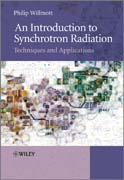
An introduction to synchrotron radiation: techniques and applications
Willmott, Philip
This book introduces the reader to the basic concepts of the generation and manipulation of synchrotron light, its interaction with matter, and the application of synchrotron light in the classical techniques, while including some ofthe most modern technological developments. As much as possible, complicated mathematical derivations and formulas are avoided. A more heuristic approach is adopted, whereby the general physical reasoning behind the equations is highlighted. Key features: A general introduction to synchrotron radiation and experimental techniques using synchrotron radiation Contains many detailed workedexamples from the literature Includes problems embedded within the appropriate part of the text to facilitate learning Of interest for a broad audience - synchrotrons are possibly one of the best examples of multidisciplinary research Four-colour presentation throughout INDICE: Preface 11 1 Introduction 11.1 A Potted History of X-rays 61.2 Synchrotron Sources over the Last Fifty Years 11References 14 2 The interaction of x-rays with matter 172.1 Introduction 172.2 The Electromagnetic Spectrum 182.3 Thomson Scattering 202.4 Compton scattering 222.5 Atomic Scattering Factors232.6 The refractive index, reflection, and absorption 282.7 X-ray fluorescence and Auger emission 352.8 Concluding remarks 41References 41 3 Synchrotron Physics 433.1 Introduction 433.2 Overview 433.3 Radiation from relativistic electrons 483.4 Radio frequency power supply and bunching 523.5 Photon beam properties 553.6 Bending magnets and superbends 613.7 Insertion devices 633.8 Future sources of synchrotron light 753.9 Concluding remarks 90References 91 4 Beamlines 934.1 Introduction 934.2 Front end 934.3 Primary optics 974.4 Microfocusand nanofocus optics 1144.5 Beam intensity monitors 1214.6 Detectors 1224.7 Time-resolved experiments 1374.8 Concluding remarks 139References 139 5 Scattering techniques 1415.1 Introduction 1415.2 Diffraction at synchrotron sources 1425.3 Description of crystals 1445.4 Basic tenets of x-ray diffraction 1495.5 Diffraction and the convolution theorem 1575.6 The phase problem and anomalousdiffraction 1605.7 Types of crystalline samples 1695.8 Single crystal diffraction 1725.9 Textured samples 1805.10 Powder diffraction 1835.11 Protein crystallography 1885.12 Ultrafast diffraction using femtoslicing 2015.13 Surface diffraction 2025.14 Resonant x-ray diffraction 2115.15 X-ray reflectometry 2145.16 Small-angle x-ray scattering 2235.17 Concluding remarks 235References 236 6 Spectroscopic techniques 2416.1 Introduction 2416.2 X-ray absorption processes2426.3 Photoelectron energies, wavelengths and absorption regions 2496.4 X-ray absorption near-edge structure, XANES 2516.5 Extended x-ray absorption fine structure, EXAFS 2606.6 Fluorescence spectroscopies 2706.7 Scanning transmission x-ray microscopy, STXM 2816.8 Photoemission electron microscopy 2876.9 Photoemission spectroscopy 2966.10 Concluding remarks 322References 322 7 Imaging techniques 3277.1 Introduction 3277.2 Computed microtomography 3287.3 Lenslessimaging 3527.4 Concluding remarks 361References 362 A Physical constants relevant to synchrotron radiation 365
- ISBN: 978-0-470-74579-3
- Editorial: John Wiley & Sons
- Encuadernacion: Cartoné
- Páginas: 360
- Fecha Publicación: 22/07/2011
- Nº Volúmenes: 1
- Idioma: Inglés
